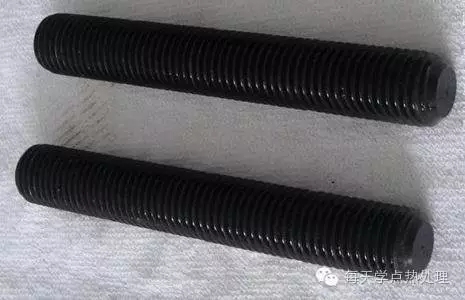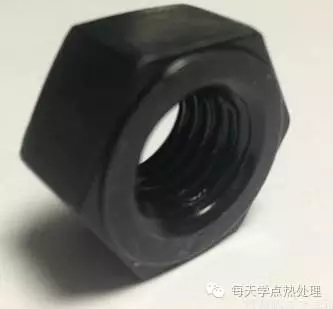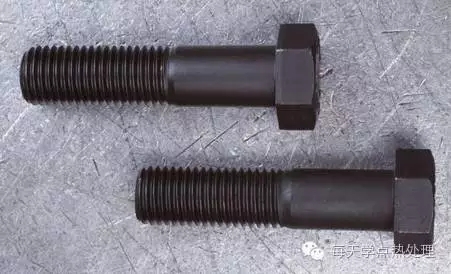Since the blackening process does not cause high-strength threaded fasteners to cause hydrogen embrittlement, it is often treated as a surface of high-strength threaded fasteners. The traditional blackening process is an alkaline blackening process. Because it requires a large work area, a large number of operating procedures, high labor intensity, high production cost, and great impact on the surrounding environment, it has gradually been replaced by many new types. The blackening process is replaced. At present, a process for blackening high-strength threaded fasteners using tempering residual temperature has been applied in many fastener manufacturing industries. This is the blackening of the residual temperature. 1, principle: Using a special residual temperature blackening agent, the tempering residual temperature of the fastener is used to generate a thermal protective film on the surface of the fastener to form a black protective film. In order to achieve the purpose of corrosion and corrosion resistance. The most important feature of this process is the combination of heat treatment equipment to achieve heat treatment and continuous work on the surface blackening operation. Increased production efficiency while reducing costs, 2, the residual temperature blackening process Fasteners-cleaning-quenching furnace-cleaning-tempering furnace-blackening-drying (or air drying) dip coating anti-rust oil 3, heat treatment equipment Generally, a continuous mesh belt quenching furnace can blacken the threaded fasteners by using a residual temperature blackening process. 4, the choice of blackening agent With the advancement of science, many domestic and foreign companies have developed the residual temperature blackening agent for such steel. In terms of selection, according to the characteristics of their own products, combined with the use range of blackening agent to select the suitable blackening agent for the company. 5, the configuration of blackening fluid The blackening liquid is concentrated, and it needs to be mixed with water before use. Generally, the ratio of conventional blackening liquid is 1:9. However, such a ratio does not necessarily have the best effect in all products. Therefore, in actual production applications, the most appropriate ratio should be configured according to the actual situation. First, the blackening agent should be uniformly stirred before the configuration, and then the proportion of the blackening liquid is determined according to the size of the fastener to be blackened and the tempering temperature. The general principle is that the concentration of the fastener is much lower, and the concentration is higher. In short, in the actual process, we must continue to summarize and explore, in order to find the best ratio of blackening agent for various specifications of threaded fasteners. 6, the precautions in the process of blackening 1) During the blackening process, the blackening effect of the product should be observed frequently, and the blackening agent should be added regularly and regularly. 7, common quality problems in the process of blackening and the causes 1) Threaded fasteners have black spots on the black surface May be: the proportion of blackening liquid is improperly formulated; 3) The surface oxide film has poor adhesion and is easy to fall off. 4) There is foreign matter on the surface of the threaded fastener after it is black, which affects the screwing property of the thread. 5) After the blackened fasteners, the surface is rusted in a short period of time. LED MR16 Spot Light,Dimmable Led Spotlights,Indoor LED Spotlights,Indoor LED Spot Light Foshan Extrlux Co., Ltd. , https://www.extrlux.com

2) When the tempering temperature is higher than 600 degrees, attention may affect the blackening effect and the adhesion of the oxide film.
3) The temperature of the blackening liquid should be monitored during the blackening process, the minimum should not be lower than 10 degrees, and the highest should not be higher than 60 degrees. When the temperature exceeds 60 degrees, the circulating stirring device should be turned on to fully cool the blackening liquid and control the liquid temperature to prevent the blackening agent from aging.
4) During the blackening process, the threaded fasteners should not accumulate too much on the mesh belt to avoid the mutual squeezing affecting the surface blackening effect.
5) Avoid harmful substances such as acid, alkali, salt and oil in the blackening process.
6) The water with the blackening liquid is best tap water, if not. It is necessary to use deep well water, and it is necessary to adjust the pH of the deep well water to 7.0-8.0 before adding it to the black liquor tank.
7) Add 50 kg of soda ash (sodium carbonate) per 10 tons, and filter the precipitate to match the blackening agent.
8) Standby PH test paper to ensure that the blackening liquid pH is between 8.0 and 9.0.
9) If the tempering temperature of the workpiece is high, slow down the speed of the hoist and try to let the workpiece travel longer in the liquid for about 40 seconds.
10) After the workpiece is blackened, it needs to be dried to prolong the anti-rust time. 
May be: the surface of the fastener is not cleaned and there are stolen goods;
The fasteners have too much black filler and are in close contact with each other, so that the blackening liquid cannot be uniformly contacted with the surface thereof;
The oxide on the surface of the thermoformed fastener is not completely removed.
2) The surface oxide film of the threaded fastener is reddish and rust-colored
The fastener also has floating rust before the surface is black;
The surface contains phosphating residues.
May be: the surface of the fastener is not clean and has oil marks;
The temperature of the blackening liquid is too high;
The corrosion of the surface of the fastener is not completely cleaned;
The blackening time is adjusted too long, so that the oxide film on the surface of the fastener is too thick to fall off.
It may be: the surface of the fastener has oxidized skin after tempering, and it falls into the blackening liquid during the blackening process;
A large amount of blackening liquid agglomerates are formed on the mesh belt furnace and adhered to the thread surface in the workpiece;
Foreign matter is mixed in the blackening liquid.
May be: the fasteners are not dried in time after drying or the drying is not completely applied to the anti-rust oil, so that there are water molecules on the surface;
The surface of the fastener is black and uneven, and the surface is covered with rust to continue to corrode;
Water may be present in the long-term anti-rust oil tank, and the water should be removed regularly.